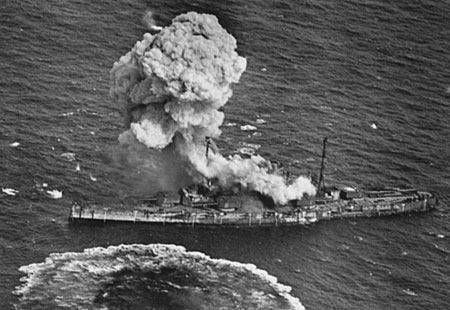
(‘Project B’ tests of aerial attacks against surface ships in 1921. Billy Mitchell had a point).
The first proposal to test nuclear weapons against naval warships was made on August 16, 1945, the day after the announcement of Japan’s surrender. There was a lot going on, now that the need to continue the war for another few years had suddenly- surprisingly- evaporated. Everything was different, a yawning chasm between everything that came before and what was going to come after.
Along with that came a host of altogether new issues with the now-public knowledge that the power of the Atom had been unleashed, and history itself seemed to have changed.
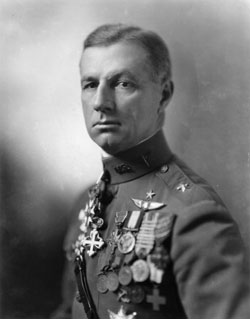
(Brevet Brigadier General Billy Mitchell. Photo US Army Air Corps).
The formal surrender in Tokyo Bay had not even occurred before the bitter infighting began behind the scenes in Washington. One of the first big scuffles was essentially about what proponents of an Air Force independent from the Army had been saying for years, which was the simple proposition that Air Power had just demonstrated at Hiroshima and Nagasaki that ground forces and navies were now obsolete and irrelevant.
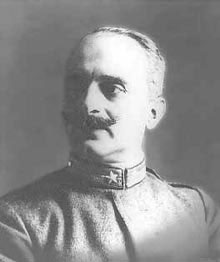
(Command of the Air theoretician Giulio Douhet).
Billy Mitchell had said the same thing years before, and with increasingly intemperate terms about the wisdom- in fact, the very patriotism- of those who opposed the ideas of Italian military theoretician Giulio Douhet. In his seminal book, Douhet argued that the power who controlled the air controlled the conduct of war itself.
The Secretary of War in 1921 was the Honorable Newton Baker, who quipped about Mitchell’s proposal to bomb ships from the air, “That idea is so damned nonsensical and impossible that I’m willing to stand on the bridge of a battleship while that nitwit tries to hit it from the air.” Likewise, the Secretary of the Navy, the Honorable Josephus Daniels, would issue the ultimate denigration of Mitchell’s vision of the potential of air power with the words, “Good God! This man should be writing dime novels.”
In so advocating the doctrine of Air Power, Mitchel increasingly angered the powers in Main Navy and the Munitions Building, who first stripped him of the brigadier star he earned for his distinguished service in France. Ultimately, they booted him out of the service itself.
Before he left active duty, Mitchell rocked the boat thoroughly. He managed to get the Army and Navy to conduct a series of joint exercises in the summer of 1921 known as “Project B.” In the trials, surplus or captured WW I warships would be used as targets to demonstrate whether they could be attacked and successfully neutralized from the air. In early tests, Mitchell’s aircraft sank a captured German destroyer and light cruiser. On July 20-21, they attacked the German battleship Ostfriesland. While the aircraft did sink it, in so doing they violated the rules of the exercise, and the Navy huffed that the demonstrations were hardly a realistic simulation of “wartime conditions.” All the target vessels were stationary and supine- defenseless.
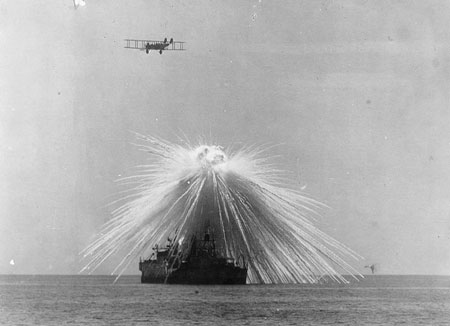
(An air corps biplane drops a white phosphorus bomb on ex-USS Alabama, September 1921).
Mitchell was dogged in his insistence that the battleships were obsolete and a wasteful diversion of resources from military aviation. For the cost of a single battleship, a thousand bombers could be procured, and the nation protected by land-based aviation. To add insult to Navy’s injury, Mitchell repeated his initial success later in September of that year by sinking the retired battleship USS Alabama (BB-8).
In the course of his scorched-earth campaign against the Generals and the Admirals doing, he incurred not just the wrath of Main Navy and the Munitions Building, but of the occupant of the White House.
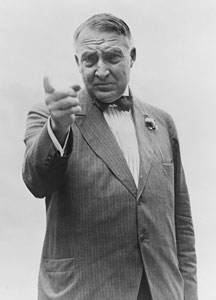
President Warren Gamaliel Harding desperately wished to avoid any show of naval weakness prior to the Naval Conference to be held in Washington in late 1921. He wanted to negotiate from a position of strength, and his “return to normalcy” for America was not going to be helped by a runway international naval arms race. Harding was concerned that limits needed to be established for warship construction and tonnage.
The United States, Great Britain, and Japan had all commenced large-scale programs of capital ship construction immediately after the end of the Great War. In the United States, this took the form of a building program to produce five new battleships and four battle-cruisers.
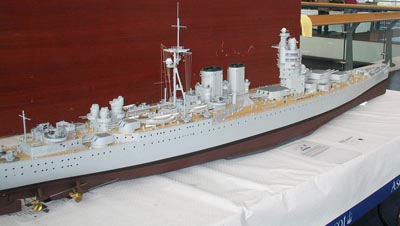
(A model of the never-built G3 Battle-cruiser).
In the UK, the preeminent global maritime power, the Royal Navy was preparing to build its series of G3 battle-cruisers and N3 battleships. For the Japanese, opportunistic member of the Allied cause, a program called for eight new battleships and eight new battle-cruisers. One of the former would live to be the last dreadnaught of the Imperial Fleet, ex-IJN Nagato which lay in Yokosuka harbor in 1946.
The Navy understood the implications of the Atomic test based on the hard lesson provided by Billy Mitchell a quarter century earlier. This was about the survival of the institution itself. The message is in the framing, of it, after all. This plan would be to demonstrate the survivability of the ships against the power of the atom.
But first, of course, someone had to get the ships the 2500 nautical miles from Yokosuka to Bikini Atoll in the Marshall Islands where the test would occur. And as part of that little task, accomplish the voyage with a Japanese battleship years past any regular maintenance, sporting unrepaired combat damage and manned by a skeleton crew of sailors with uncertain motivation, none of whom could read a word of Japanese.
Captain William J. Whipple, USN, was just the man to get the job done. At least, that is what Ed Gilfillen thought.
We will get to that tomorrow.
Copyright 2015 Vic Socotra
www.vicsocotra.com
Twitter: @jayare303
